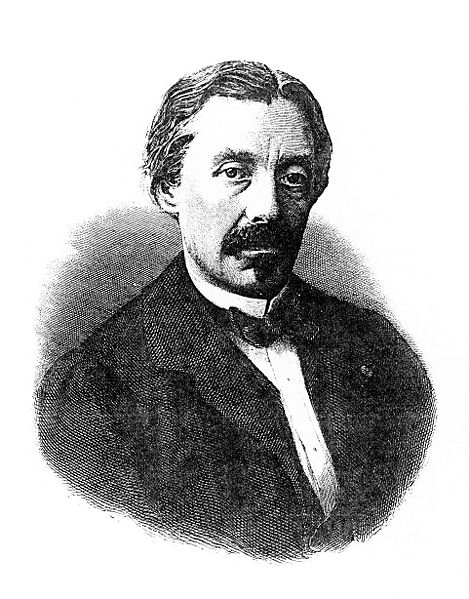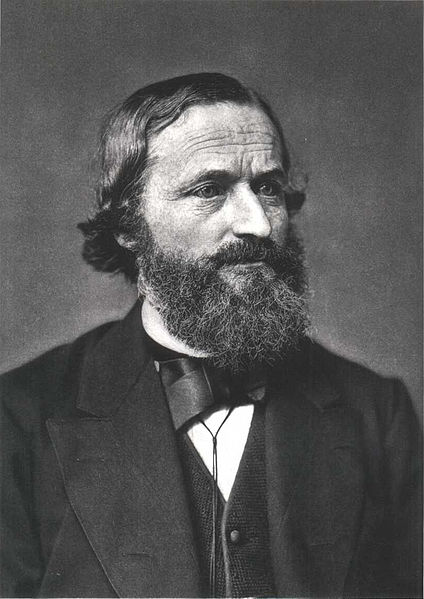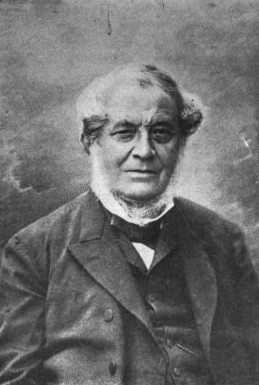<Back to Index>
- Physicist Jean Bernard Léon Foucault, 1819
- Physicist Gustav Robert Kirchhoff, 1824
- Chemist Robert Wilhelm Eberhard Bunsen, 1811
PAGE SPONSOR

Jean Bernard Léon Foucault (18 September 1819 – 11 February 1868) was a French physicist best known for the invention of the Foucault pendulum, a device demonstrating the effect of the Earth's rotation. He also made an early measurement of the speed of light, discovered eddy currents, and although he didn't invent it, is credited with naming the gyroscope.
Foucault was the son of publisher in Paris, where he was born on September 18, 1819. After an education received chiefly at home, he studied medicine, which he abandoned in favor of physics due to a fear of blood. He first directed his attention to the improvement of L.J.M. Daguerre's photographic processes. For three years he was experimental assistant to Alfred Donné (1801 – 1878) in his course of lectures on microscopic anatomy.
With A.H.L. Fizeau he carried out a series of investigations on the intensity of the light of the sun, as compared with that of carbon in the arc lamp, and of lime in the flame of the oxyhydrogen blowpipe; on the interference of infrared radiation, and of light rays differing greatly in lengths of path; and on the chromatic polarization of light.
In 1850, he did an experiment using the Fizeau – Foucault apparatus to measure the speed of light; it came to be known as the Foucault – Fizeau experiment, and was viewed as "driving the last nail in the coffin" of Newton's corpuscle theory of light when it showed that light travels more slowly through water than through air.
In 1851, he provided the first experimental demonstration of the rotation of the Earth on its axis (diurnal motion). He achieved this by showing the rotation of the plane of oscillation of a long and heavy pendulum suspended from the roof of the Panthéon in Paris. The experiment caused a sensation in both the learned and popular worlds, and "Foucault pendulums" were suspended in major cities across Europe and America and attracted crowds. In the following year he used (and named) the gyroscope as a conceptually simpler experimental proof. In 1855, he received the Copley Medal of the Royal Society for his 'very remarkable experimental researches'. Earlier in the same year he was made physicien (physicist) at the imperial observatory at Paris.
In September, 1855, he discovered that the force required for the rotation of a copper disc becomes greater when it is made to rotate with its rim between the poles of a magnet, the disc at the same time becoming heated by the eddy current or "Foucault currents" induced in the metal.
In 1857, Foucault invented the polarizer which bears his name, and in the succeeding year devised a method of testing the mirror of a reflecting telescope to determine its shape. The so-called "Foucault knife - edge test" allows the worker to tell if the mirror is perfectly spherical or has non - spherical deviation in its figure. Prior to Foucault's publication of his findings, the testing of reflecting telescope mirrors was a "hit or miss" proposition.
Foucault's knife edge test determines the shape of a mirror by finding the focal lengths of its areas, commonly called zones and measured from the mirror center. The test focuses light point source at the center of curvature and reflected back to a knife edge. The test enables the tester to quantify the conic section of the mirror, thereby allowing the tester to validate the actual shape of the mirror, which is necessary to obtain optimal performance of the optical system. The Foucault test is in use to this date, most notably by amateur and smaller commercial telescope makers as it is inexpensive and uses simple, easily made equipment.
With Charles Wheatstone’s revolving mirror he, in 1862, determined the speed of light to be 298,000 km/s (about 185,000 mi./s) - 10,000 km/s less than that obtained by previous experimenters and only 0.6% off the currently accepted value.
In that year, he was made a member of the Bureau des Longitudes and an officer of the Légion d'Honneur.
In 1864 he was made a member of the Royal Society of London, and the
next year a member of the mechanical section of the Institute. In 1865
his papers on a modification of Watt's
governor appeared, upon which he had for some time been experimenting
with a view to making its period of revolution constant, and on a new
apparatus for regulating the electric light; and in the year (Compt.
Rend. lxiii.) he showed how, by the deposition of a transparently thin
film of silver
on the outer side of the object glass of a telescope, the sun could be
viewed without injuring the eye. His chief scientific papers are to be
found in the Comptes Rendus, 1847 - 1869.
Foucault died of what was probably a rapidly developing case of multiple sclerosis on February 11, 1868 in Paris and was buried in the Cimetière de Montmartre.
The asteroid 5668 Foucault is named for him. His name is one of the 72 names inscribed on the Eiffel Tower.

Gustav Robert Kirchhoff (12 March 1824 – 17 October 1887) was a German physicist who contributed to the fundamental understanding of electrical circuits, spectroscopy and the emission of black - body radiation by heated objects. He coined the term "black body" radiation in 1862, and two sets of independent concepts in both circuit theory and thermal emission are named "Kirchhoff's laws" after him, as well as a law of thermochemistry. The Bunsen – Kirchhoff Award for spectroscopy is named after him and his colleague, Robert Bunsen.
Gustav Kirchhoff was born in Königsberg, East Prussia, the son of Friedrich Kirchhoff, a lawyer, and Johanna Henriette Wittke. He graduated from the Albertus University of Königsberg in 1847 where he attended the mathematico - physical seminar directed by Franz Ernst Neumann and Friedrich Julius Richelot. He married Clara Richelot, the daughter of his mathematics professor Richelot. In the same year, they moved to Berlin, where he stayed until he received a professorship at Breslau.
Kirchhoff formulated his circuit laws, which are now ubiquitous in electrical engineering, in 1845, while still a student. He completed this study as a seminar exercise; it later became his doctoral dissertation. In 1857 he calculated that an electric signal in a resistanceless wire travels along the wire at the speed of light. He proposed his law of thermal radiation in 1859, and gave a proof in 1861. He was called to the University of Heidelberg in 1854, where he collaborated in spectroscopic work with Robert Bunsen. Together Kirchhoff and Bunsen discovered caesium and rubidium in 1861. At Heidelberg he ran a mathematico - physical seminar, modeled on Neumann's, with the mathematician Leo Koenigsberger. Among those who attended this seminar were Arthur Schuster and Sofia Kovalevskaya. In 1875 Kirchhoff accepted the first chair specifically dedicated to theoretical physics at Berlin.
In 1862 he was awarded the Rumford Medal for his researches on the fixed lines of the solar spectrum, and on the inversion of the bright lines in the spectra of artificial light.
He contributed greatly to the field of spectroscopy by formalizing three laws that describe the spectral composition of light emitted by incandescent objects, building substantially on the discoveries of David Alter and Anders Jonas Angstrom (see also: spectrum analysis).
He also contributed to optics, carefully solving Maxwell's equations to provide a solid foundation for Huygen's principle (and correcting it in the process).
Kirchhoff died in 1887, and was buried in the St Matthäus Kirchhof Cemetery in Schöneberg, Berlin.
Kirchhoff's three laws of spectroscopy
- A hot solid object produces light with a continuous spectrum.
- A hot tenuous gas produces light with spectral lines at discrete wavelengths (i.e., specific colors) which depend on the energy levels of the atoms in the gas. (emission spectrum)
- A hot solid object surrounded by a cool tenuous gas (i.e., cooler than the hot object) produces light with an almost continuous spectrum which has gaps at discrete wavelengths depending on the energy levels of the atoms in the gas. (absorption spectrum)
Kirchhoff did not know about the existence of energy levels in atoms. The existence of discrete spectral lines was later explained by the Bohr model of the atom, which helped lead to quantum mechanics.
Kirchhoff showed in 1858 that the variation of the heat of a chemical reaction is given by the difference in heat capacity between products and reactants: dΔH / dT = ΔCp.
Integration of this equation permits the evaluation of the heat of
reaction at one temperature from measurements at another temperature.

Robert Wilhelm Eberhard Bunsen (30 March 1811 – 16 August 1899) was a German chemist. He investigated emission spectra of heated elements, and discovered caesium (in 1860) and rubidium (in 1861) with Gustav Kirchhoff. Bunsen developed several gas - analytical methods, was a pioneer in photochemistry and did early work in the field of organoarsenic chemistry. With his laboratory assistant, Peter Desaga, he developed the Bunsen burner, an improvement on the laboratory burners then in use. The Bunsen – Kirchhoff Award for spectroscopy is named after Bunsen and Kirchhoff.
Robert Bunsen was born at Göttingen in 1811 in what is now the state of Lower Saxony in Germany, but was then the short lived Kingdom of Westphalia; upon the defeat of Napoleon three years later it became the Kingdom of Hanover. Robert was the youngest of four sons of the University of Göttingen's chief librarian and professor of modern philology, Christian Bunsen (1770 – 1837). Sources disagree on Robert Bunsen's exact birth date. His parish register, as well as two curricula vitae, handwritten by Bunsen himself, support the claim that 30 March 1811 is Bunsen's true birth date; however, many later sources cite 31 March as the date. According to his biographer Georg Lockemann, Bunsen himself celebrated his birthday on the 31st in his later years. Lockemann nevertheless regarded the 30th as the correct date.
After attending school in Holzminden, Bunsen matriculated at Göttingen in 1828 and studied chemistry with Friedrich Stromeyer as well as mineralogy with Johann Friedrich Ludwig Hausmann and mathematics with Carl Friedrich Gauss. After obtaining a Ph.D. in 1831, Bunsen spent 1832 and 1833 traveling in Germany, France and Austria; Friedlieb Runge (who discovered aniline and in 1819 isolated caffeine), Justus von Liebig in Gießen, and Eilhard Mitscherlich in Bonn were among the many scientists he met on his journeys.
In 1833 Bunsen became a lecturer at Göttingen and began experimental studies of the (in)solubility of metal salts of arsenous acid. His discovery of the use of iron oxide hydrate as a precipitating agent is still today the most effective antidote against arsenic poisoning. In 1836, Bunsen succeeded Friedrich Wöhler at the Polytechnic School of Kassel. Bunsen taught there for three years, and then accepted an associate professorship at the University of Marburg, where he continued his studies on cacodyl derivatives. He was promoted to full professorship in 1841.
Bunsen's work brought him quick and wide acclaim, partly because
cacodyl, which is extremely toxic and undergoes spontaneous combustion
in dry air, is so difficult to work with. Bunsen almost died from arsenic poisoning, and an explosion with cacodyl cost him sight in his right eye. In 1841, Bunsen created the Bunsen cell battery, using a carbon electrode instead of the expensive platinum electrode used in William Robert Grove's electrochemical cell. Early in 1851 he accepted a professorship at the University of Breslau, where he taught for three semesters.
In late 1852 Bunsen became the successor of Leopold Gmelin at the University of Heidelberg. There he used electrolysis to produce pure metals, such as chromium, magnesium, aluminum, manganese, sodium, barium, calcium and lithium. A long collaboration with Henry Enfield Roscoe began in 1852, in which they studied the photochemical formation of hydrogen chloride from hydrogen and chlorine. He discontinued his work with Roscoe in 1859 and joined Gustav Kirchhoff to study emission spectra of heated elements, a research area called spectrum analysis. For this work, Bunsen and his laboratory assistant, Peter Desaga, had perfected a special gas burner by 1855, influenced by earlier models. The newer design of Bunsen and Desaga, which provided a very hot and clean flame, is now called simply the "Bunsen burner".
There had been earlier studies of the characteristic colors of heated elements, but nothing systematic. In the summer of 1859, Kirchhoff suggested to Bunsen that he try to form prismatic spectra of these colors. By October of that year the two scientists had invented an appropriate instrument, a prototype spectroscope. Using it, they were able to identify the characteristic spectra of sodium, lithium and potassium. After numerous laborious purifications, Bunsen proved that highly pure samples gave unique spectra. In the course of this work, Bunsen detected previously unknown new blue spectral emission lines in samples of mineral water from Dürkheim. He guessed that these lines indicated the existence of an undiscovered chemical element. After careful distillation of forty tons of this water, in the spring of 1860 he was able to isolate 17 grams of a new element. He named the element "caesium", after the Latin word for deep blue. The following year he discovered rubidium, by a similar process.
In 1860, Bunsen was elected a foreign member of the Royal Swedish Academy of Sciences.
Bunsen was one of the most universally admired scientists of his generation. He was a master teacher, devoted to his students, and they were equally devoted to him. At a time of vigorous and often caustic scientific debates, Bunsen always conducted himself as a perfect gentleman, maintaining his distance from theoretical disputes. He much preferred to work quietly in his laboratory, continuing to enrich his science with useful discoveries. As a matter of principle he never took out a patent. He never married.
When Bunsen retired at the age of 78, he shifted his work solely to geology and mineralogy, an interest which he had pursued throughout his career. He died in Heidelberg, aged 88.